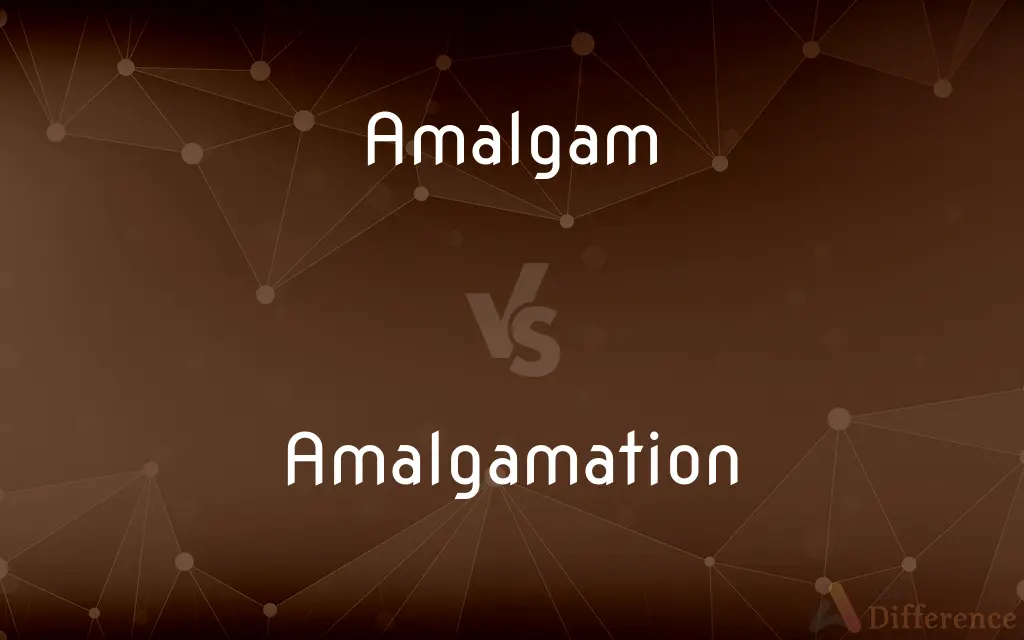Amalgam vs. Amalgamation — What's the Difference?
By Tayyaba Rehman — Updated on October 28, 2023
Amalgam refers to a mixture or blend, often of metals; Amalgamation is the process or action of combining or uniting things, especially companies or organizations.

Difference Between Amalgam and Amalgamation
Table of Contents
ADVERTISEMENT
Key Differences
Amalgam is primarily a noun that denotes a mixture or blend. This term is often associated with the combination of metals, especially mercury with another metal. On the other hand, Amalgamation is both a noun and a process. It signifies the action or process of combining or uniting entities.
At its core, Amalgam represents the end result – the final blend or mixture formed after combining elements. In contrast, Amalgamation emphasizes the act or journey of merging, often used in a corporate or organizational context to indicate a merger.
While Amalgam can be used to describe the blend of ideas, characteristics, or cultures, it is often confined to the realm of substances or materials. Amalgamation, however, boasts a broader application, extending beyond materials to include abstract concepts like merging companies or cultures.
In dentistry, Amalgam refers to a specific filling material made of mixed metals. Meanwhile, Amalgamation in the business world is about consolidating companies or assets, often for strategic advantages.
It’s essential to understand the context when using these terms. While Amalgam often points to the tangible or the substance, Amalgamation is more about the act or process, even when the results are intangible.
ADVERTISEMENT
Comparison Chart
Part of Speech
Noun
Noun, Process
Primary Usage
Blend or mixture, especially of metals
Process of combining or uniting
Context
Materials, substances, dentistry
Corporate mergers, unifying concepts or cultures
Result vs. Process
Represents the end result or blend
Emphasizes the act or process of merging
Tangibility
Often refers to tangible mixtures
Can be both tangible (companies) and intangible (ideas)
Compare with Definitions
Amalgam
A blend or mixture of different elements.
The festival is an amalgam of various cultural performances.
Amalgamation
The act or result of blending different elements.
The book is an amalgamation of various folk tales.
Amalgam
A dental filling material made from a mixture of metals.
The dentist used amalgam to fill the cavity.
Amalgamation
Consolidation of assets, resources, or entities.
The government proposed the amalgamation of neighboring towns.
Amalgam
A combination of mercury with another metal.
Silver amalgam is commonly used in various applications.
Amalgamation
The process of combining or uniting to form one entity.
The amalgamation of the two companies resulted in a stronger entity.
Amalgam
An alloy of mercury with another element.
Gold amalgam is used in some specialized processes.
Amalgamation
A merger, especially of companies or organizations.
The bank’s recent amalgamation has expanded its reach.
Amalgam
An alloy of mercury and silver used in dental fillings.
Amalgamation
The act of amalgamating or the condition resulting from this act.
Amalgam
An alloy of mercury and tin used in silvering mirrors.
Amalgamation
A consolidation or merger, as of several corporations.
Amalgam
A combination of diverse elements; a mixture
An amalgam of strength, reputation, and commitment to ethical principles.
Amalgamation
The production of a metal alloy of mercury.
Amalgam
(metallurgy) An alloy containing mercury.
Amalgamation
The process of amalgamating; a mixture, merger or consolidation.
Amalgam
A combination of different things.
Amalgamation
The result of amalgamating; a mixture or alloy.
Amalgam
One of the ingredients in an alloy.
Amalgamation
(specifically) The production of an alloy of mercury and another metal.
Amalgam
To amalgamate.
Amalgamation
(obsolete) The intermarriage and interbreeding of different ethnicities or races.
Amalgam
An alloy of mercury with another metal or metals; as, an amalgam of tin, bismuth, etc.
Amalgamation
The act or operation of compounding mercury with another metal; - applied particularly to the process of separating gold and silver from their ores by mixing them with mercury.
Amalgam
A mixture or compound of different things.
Amalgamation
The mixing or blending of different elements, races, societies, etc.; also, the result of such combination or blending; a homogeneous union.
Amalgam
A native compound of mercury and silver.
Amalgamation
The combination of two or more commercial companies
Amalgam
To amalgamate.
Amalgamation
The fusion or coalescence of entities or ideas.
The new software is an amalgamation of the best features from previous versions.
Amalgam
An alloy of mercury with another metal (usually silver) used by dentists to fill cavities in teeth; except for iron and platinum all metals dissolve in mercury and chemists refer to the resulting mercury mixtures as amalgams
Amalgam
A combination or blend of diverse things;
His theory is an amalgam of earlier ideas
Amalgam
A unified product from combining diverse elements.
The painting is an amalgam of different styles and techniques.
Common Curiosities
Is dental Amalgam safe?
Dental amalgam, containing mercury, is deemed safe by many dental associations, but concerns persist. Always consult with a dentist.
Can Amalgam refer to non-metal mixtures?
Yes, Amalgam can denote a blend of ideas, cultures, or characteristics, but it's often associated with metals.
Can Amalgamation refer to cultural contexts?
Yes, Amalgamation can signify the merging of cultures or ideas.
Why is Amalgamation significant in business?
Amalgamation in business can offer strategic advantages, resource optimization, and market expansion.
What's the relationship between Amalgam and Amalgamation?
Amalgam often signifies the product or result, while Amalgamation denotes the process or action of merging.
Are Amalgam fillings still popular in dentistry?
While Amalgam fillings are still used, alternatives like composite fillings have become popular.
What does Amalgamation represent?
Amalgamation represents the process or action of combining or uniting entities.
In what context is Amalgamation typically used?
Amalgamation is frequently used in a corporate context, indicating the merger of companies.
Are all Amalgams mercury-based?
Most traditional amalgams are mercury-based, but the term can be used broadly for other mixtures too.
Can Amalgam be used metaphorically?
Yes, Amalgam can metaphorically describe a mix of ideas or qualities.
What is the primary usage of Amalgam?
Amalgam primarily refers to a mixture or blend, often of metals.
How does Amalgamation affect corporate identities?
Amalgamation can result in a new corporate identity, combining elements of the merged entities.
Can Amalgamation refer to physical substances?
While Amalgamation often refers to abstract combinations, it can denote the process of combining physical substances as well.
Does Amalgamation always result in a stronger entity?
Not necessarily. The success of an Amalgamation depends on various factors, including execution and market dynamics.
How are Amalgams formed?
Amalgams are formed by combining mercury with another metal or element.
Share Your Discovery

Previous Comparison
Gorilla vs. Guerrilla
Next Comparison
Seminar vs. TutorialAuthor Spotlight
Written by
Tayyaba RehmanTayyaba Rehman is a distinguished writer, currently serving as a primary contributor to askdifference.com. As a researcher in semantics and etymology, Tayyaba's passion for the complexity of languages and their distinctions has found a perfect home on the platform. Tayyaba delves into the intricacies of language, distinguishing between commonly confused words and phrases, thereby providing clarity for readers worldwide.
















































